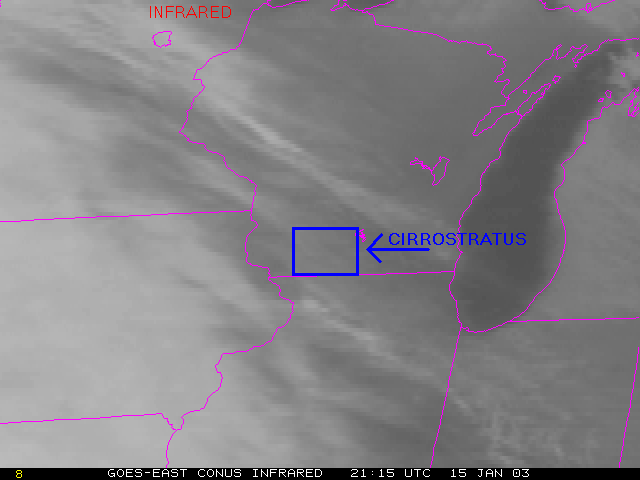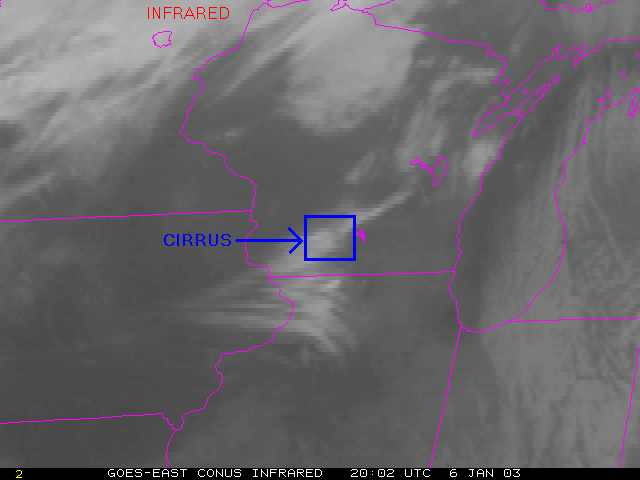In 101: Clouds II, I covered the low etage of clouds,
consisting of five genera. In this post I’ll cover the middle and high etages,
beginning with the former. The two genera of middle clouds have bases around
2-7km; it is at these altitudes where clouds regularly consist of a mix of
water droplets, ice crystals, and super-cooled water droplets. Super-cooled
water is water that is below freezing temperature, but remains a liquid until
either the temperature cools even more, or particles in the air (such as other
ice crystals) come in contact with the droplets, causing them to instantly
freeze. An example of this state of water can be seen with a simple experiment:
place a few small, equally sized drops of water on a smooth, clean metal
surface, such as the underside of a soup can, and then put it in the freezer.
Check on the drops every few minutes until they begin to freeze. More than
likely, there will be a time when some of the drops have frozen while the
others remain liquid. Since the metal surface conducts heat well, you can be
sure that all the drops are at essentially the same temperature, thus the drops
that are still liquid must be below freezing, and therefore they are
super-cooled drops. Since a small change in temperature or the presence of ice
forming particles can cause super-cooled droplets to become regular liquid
water or ice crystals, respectively, clouds that consist of these drops are
often in a constant state of change.
These cumuliform clouds often resemble stratocumulus clouds,
only noticeably higher. Weak convection in a mid-level layer of moisture is
often the cause of these clouds, thus they typically do not show much vertical
extent, except in the case of the Altocumulus castellanus. In the case of
Altocumulus stratiformis, the individual cloud elements are often very flat and
without much space between them; this is sometimes referred to as “mackerel
sky”. On satellite imagery, altocumulus appears similar to stratocumulus,
except a little brighter on infrared images, since they are cooler.
Altostratus (As)
 |
| Altostratus with small cumulus closer to the ground |
 |
| Altostratus (As) as it appears on visible imagery |
 |
| Altostratus (As) as it appears on infrared imagery |
This genus of stratiform cloud regularly occurs ahead of an
approaching warm front. They will likely be preceded by cirrostratus and
followed by stratus or nimbostratus. While they rarely produce precipitation
that reaches the surface, the undersides of these clouds will often exhibit
streaks of precipitation that evaporates before reaching the surface, called
virga. If the layer the virga are evaporating into becomes saturated, a cloud
may form, effectively lowering the cloud base. If this continues, precipitation
from the descending cloud will reach the ground, marking the transition from
altostratus to nimbostratus. Altostratus differs from its lower counterparts in
that the sun is usually very apparent, especially in the case of Altostratus translucidus.
While often very featureless, the Altostratus undulatus species often displays
a wavy underside much like Stratus
undulatus. In both visible and infrared satellite images, altostratus appears
very similar to nimbostratus.
High Clouds
The final etage is the high clouds. These clouds have bases
at about 5-13km, although in the tropics they may have bases as high as 18km.
At this height, clouds consist almost entirely of ice crystals. While these
clouds often precede weather systems, they themselves never produce
precipitation that reaches the ground, although virga consisting of ice
crystals are quite common.
Cirrus are the quintessential ice cloud. There are many
different species of this genus, but all are composed of wisps of white cloud,
hence the name “cirrus”, which comes from the Latin term for lock or curl of
hair. These clouds are often composed of two parts: a dense cloudlet and a long
streak of ice crystals being blown downwind. When there are relatively few
streaks the cloud is of the Cirrus floccus species, when the opposite is true
and the source cloudlets are absent the cloud is of the Cirrus fibratus species.
In the case of the Cirrus castellanus species a small amount of vertical growth
in the form of small turrets will appear along the top of the cloud. Finally,
the strangest species is Cirrus vertebratus, which appears to have fall streaks
extending in opposite directions forming what vaguely resembles a rib cage,
which is where the name “vertebratus” comes from. The tops of tall cumulonimbus
will consist of thick cirrus clouds that may drastically outlive the parent
cumulonimbus cloud. Cirrus appears on visible satellite images as streaks of
white cloud that may cast noticeable shadows on lower clouds and may seem
somewhat transparent. On infrared images, cirrus will appear as wisps of bright
white to medium grey, depending on the density of the clouds.
 |
| This is an infrared image at the same time as the visible picture above |
This high cloud is the only genus in this etage to contain a
small amount of super-cooled water droplets. As with the super-cooled water in
the middle clouds, any particles in the air will cause the water to instantly
freeze, at which point the cloud will consist of only ice and will have
essentially become a cirrus cloud. It is for this reason that cirrocumulus
clouds are the rarest of the ten official cloud genera, since they are likely
in the process of becoming a cirrus or cirrostratus cloud. Sometimes this genus
will appear in extensive sheets of more-or-less uniform cloud elements; this is
the Cirrocumulus stratiformis species. Another species, Cirrocumulus undulatus, will exhibit some wave-like
patterns, in much the same manner as the undulatus species of lower cloud genera. This
genus of clouds appears as a rough patch of clouds, possibly casting a shadow
on clouds below, on visible satellite images and as a white to light grey patch
on infrared images. In general however, cirrocumulus can often be hard to
distinguish from other genera on satellite.
 |
| Cirrostratus as it appears on infrared imagery |
The last of the ten genera of clouds is cirrostratus. This genus
often consists of an incredibly extensive layer of very thin cloud. It can be
so thin, as is often the case with Cirrostratus nebulosus, that it can go
unnoticed by observers on the ground. Because of their transparency, these
clouds often produce vivid optical phenomena, such as halos, which are rings
around the sun that might exhibit bright colors. In some cases, this genus can
display some variety, such as in Cirrostratus undulatus, which appears to have
ripples. Features in cirrostratus likely signifies that the cloud began as
cirrocumulus that has since completely frozen. Due to the typical uniformity
and thinness of this genus, they may be hard to spot on visible images and can
often appear as the same shade as low layer clouds on infrared satellite imagery.






































No comments:
Post a Comment